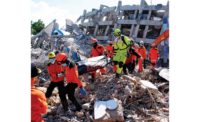 |
Bruce Turner, a geophysicist at the WCATWC which was established in 1967, says the system worked "exactly as intended" after 130 seismic sensors detected a rumble exceeding the trigger of 7.1 magnitude set when a quake of that size hit Alaska in 1964, killing seven people there and another 160 in Hawaii hours later. Tuesdays event was 91 miles off the coast of Northern California at 7:50 in the evening Pacific Time. Within five minutes a warning went to the Emergency Alert System, which broadcast the news to televisions and radios up and down the coast. WCATWC computers calculated arrival times (Humboldt Bay was the closest with an estimated arrival time of 32 minutes after the quake) and sent notices to Emergency Services Personnel who decided whether to mobilize their individual populations. The only town to actually evacuate was Crescent City, which still lives in the shadow of a wave that hit the town in 1964, killing 11 people.
Approximately one half hour after the warning, it was determined that the earthquake was a horizontal, strike-slip event, meaning that it lacked the vertical movement present in most tsunami events. "That allowed us to breathe easier," Turner says. It was only an hour after the event, however, when tide gauges in harbors on shore detected no waves and a Deep Ocean Assessment and Reporting of Tsunamis (DART) Buoy 256 miles at sea off the California-Oregon border measured only a miniscule wave that the warning was called off at 9:09 p.m.
"My only concern is that if we cry wolf too many times people may stop reacting," Turner says. He is currently evaluating how the system worked and looking for ways to improve, including the ability to send the warning to only selected areas close to the event initially. He is also interested in how studies of subduction zones being done by UC Berkeley, Dalhousie University in Nova Scotia and University of Alaska, Fairbanks, could predict when the earth is primed for its next big rumble. "This research is all well and good, but we have to make sure it is practical given the resources available," Turner says.
One change that was made last year after the devastating Sumatra tsunami in December is the addition of Atlantic to the WCATWCs warning network. Although it does not operate DART Buoys outside the Pacific, information from tide gauges and seismic meters is being routed to WCATWC and message systems are being set up to distribute the information. "Tsunamis are rare in the Atlantic, but it could have a devastating impact as we saw last year."
The rest of the world is reacting to the call for a global warning system in its own way. In a Regional Tsunami Warning and Mitigation System for the Indian Ocean report presented at an Asian Pacific All Hazards Workshop in June, the Intergovernmental...


Post a comment to this article
Report Abusive Comment